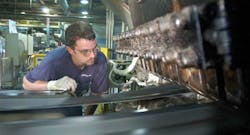In a matchup intended to reduce the costs of truck tire ownership, Bridgestone Commercial Solutions (BCS) has paired up its Bridgestone Ecopia truck tire line with complementary Bandag FuelTech treads.
The tires and retreads were covered in detail at a recent media tour at Bridgestone Americas Tire Operations’ (BATO) Warren County, Tenn., plant. The five new tires in the Bridgestone Ecopia line are for the steer, drive and trailer positions. The four new tread designs, in the Bandag FuelTech line, are for drive and trailer tires.
“Ecopia is trying to solve the great tire technology challenge of optimizing wear and rolling resistance without sacrificing wet traction,” says Scott Damon, vice president of marketing. “With $4 diesel, fuel efficiency becomes a huge issue. From a fleet perspective, there are several variables that affect the rolling resistance of a truck.
Tires are one of those elements, and trying to isolate the tire effect from that so it can have real meaning to a customer, it’s critical.”
Damon says BCS added smarter designs and new technology in Ecopia products. The company also implemented technologies that extend the life of an Ecopia casing for Bandag FuelTech products.
“These changes mean greater fuel savings for our customers that can contribute to a lower cost of ownership over the life of the tires.”
Damon says the technologies BCS has developed offer significant benefits for both Ecopia and FuelTech products. Within the tire tread, Bridgestone’s patented NanoPro-Tech polymer technology, available in all new Ecopia tires, helps control particle movement, which reduces energy loss. That translates into improved fuel economy through lower rolling resistance.
Bridgestone says its proprietary Fuel Saver Sidewall compound reduces heat generation, which lowers rolling resistance and improves fuel economy.
The new IntelliShape sidewall, found in the M710 Ecopia drive radial and R197 Ecopia trailer tire, contain less bead filler volume, which lowers tire weight, improving fuel economy and conserving natural resources.
A new Defense Side Groove feature has been incorporated into the R283 Ecopia steer tire, which creates uniform pressure along the footprint at the shoulder and helps extend tread life.
The patented Waved Belt design in Greatec Ecopia tires improves durability, contributing to a more retreadable casing, especially when paired with a Bandag FuelTech product. The use of patented Turn-In-Ply technology enhances durability and retreadability over the life of the casing.
The B710 FuelTech drive and B197 FuelTech trailer retreads complement the new drive and trailer Ecopia tires. For users of wide-base truck tires, Bandag B835 FuelTech and B135 FuelTech retreads are based on the new Bridgestone Greatec M835 Ecopia drive and Greatec R135 Ecopia trailer radials.
BCS isn’t leaving customers in the dark as to how they can calculate fuel savings with these tires and retreads. With the Ecopia lineup, BCS also launched www.ecopiatrucktires.com where customers can get in-depth, detailed testimonials along with videos on the products. In addition, there is a new proprietary system called the Online Life Cycle Cost Calculator.
“You can actually take your purchase price of the products and the current cost of diesel and can get your total life cycle cost savings of this product through its retread life and through its reduced CO2 emissions and compare it against any product in the market today,” says Damon. “It’s a very unique and simplistic tool but it does show the value of the Ecopia products.” ■
[PAGEBREAK]
Who’s the boss?
The folks at Bridgestone Commercial Solutions (BCS) have a unique concept of what a “boss” is. BCS uses feedback from this boss to better design commercial truck tires.
“What we try to do is take the boss, our customers, and say, ‘how do I create inspired ideas from the boss in the tire development process?’” says Scott Damon, vice president of marketing at BCS. “There are several things we do as a marketing organization, and try to capture what our customers tell us through predictive models such as observational interviews.”
Damon says that customer feedback reveals a concern of regulatory mandates such as those coming from the California Air Resources Board (CARB). Many regulations affect truck tires, and BCS customers need OTR tires that are in compliance with rules and that save fuel, such as with the Environmental Protection Agency’s (EPA) SmartWay program.
“We try to capture what our customers say, what our sales force says and what our distributors say,” says Damon. “We mine the insights from that feedback and say, ‘How can we create a solution that will have value in the marketplace?’ It might be a product solution. It could be a service solution.”
Damon says this process has worked very effectively for BCS. He says that as one of the top three tire companies, two out of the top-four selling brands in North America for truck tires are manufactured by Bridgestone.
“And, we’re roughly half the retread market in North America,” he says. “One in three of every tire wheel position in the market is a Bridgestone-generated product.”
With all those Bridgestone products out there, Damon says BCS wants to help customers manage these assets.
“With large fleets like Ryder and UPS, they try to manage their assets, including their worn tire casings, across multiple dealers and multiple states,” Damon explains.
“This has allowed us to take a system that we have in place and actually track those assets online via a Web portal so their maintenance facility managers can see where their inventory is sitting and best leverage that across a network of independent dealers.”



